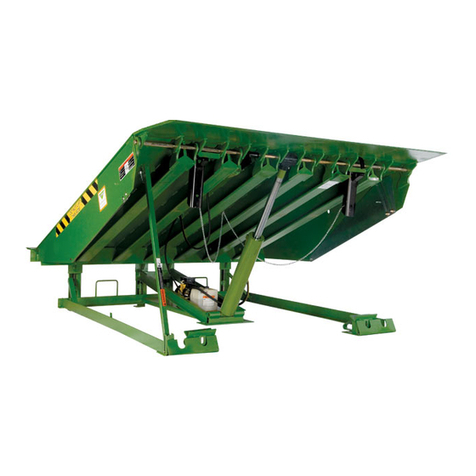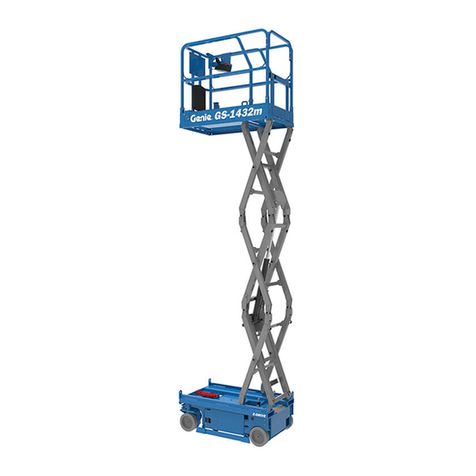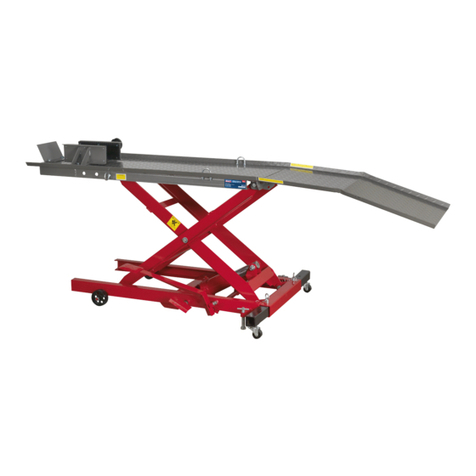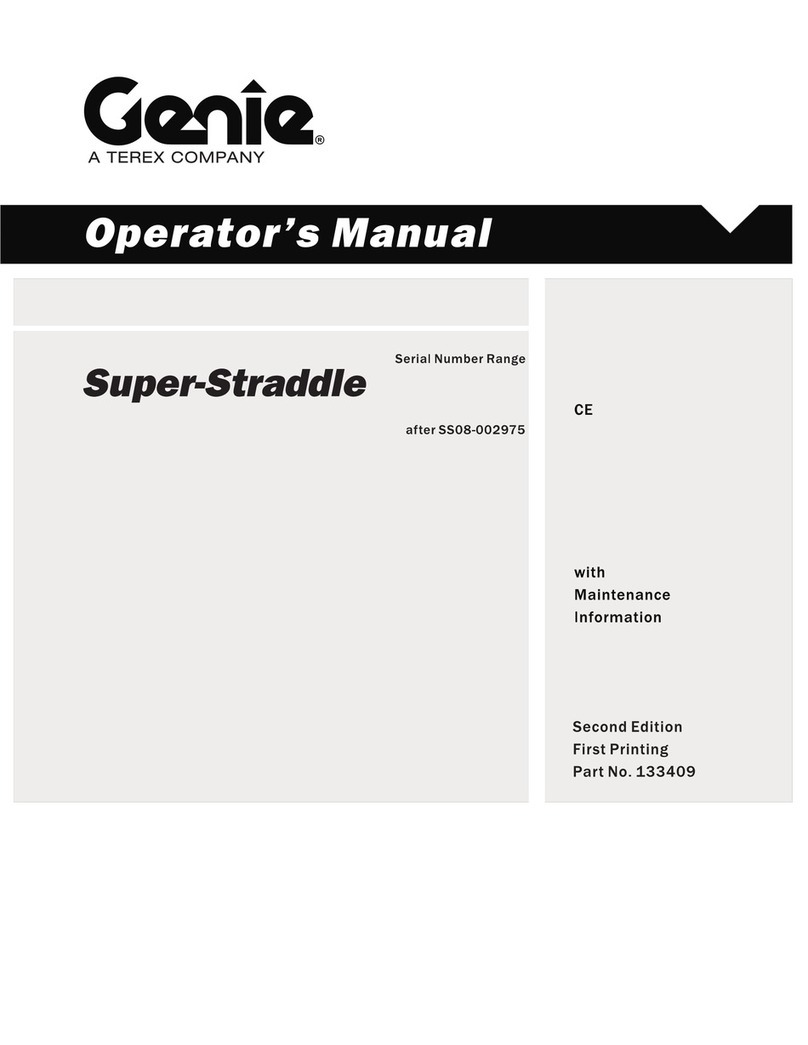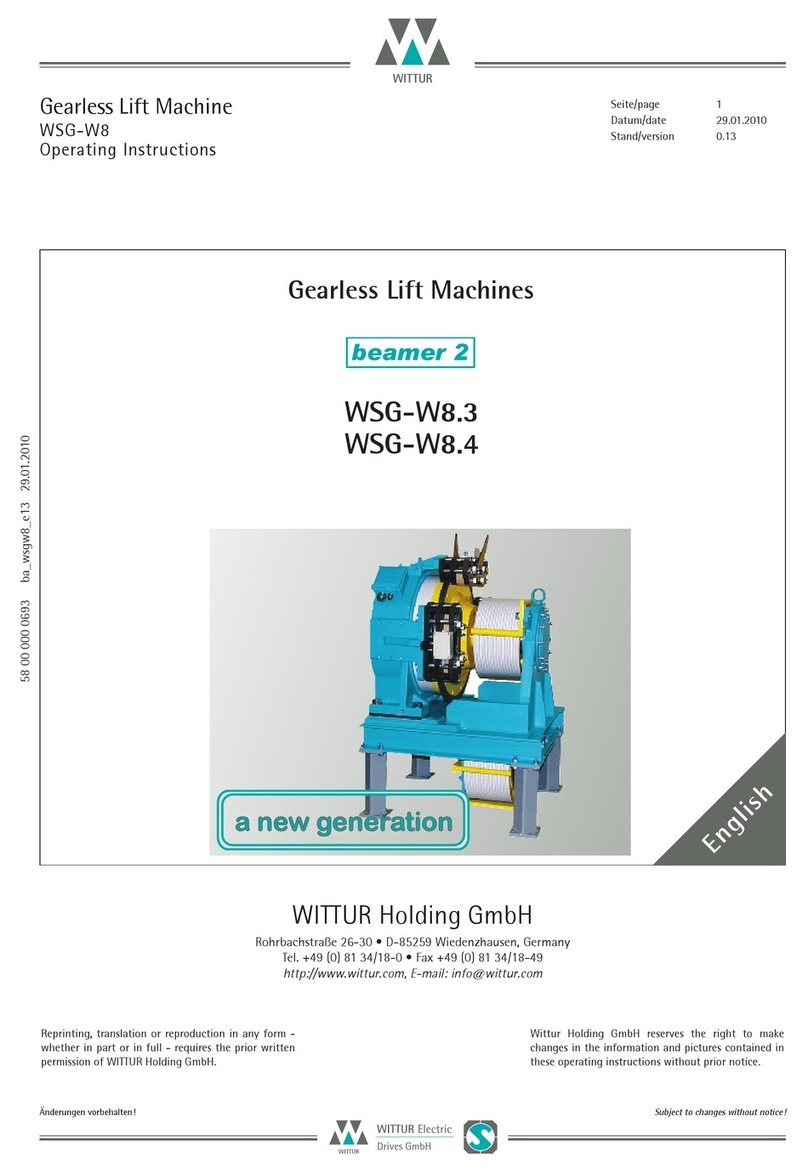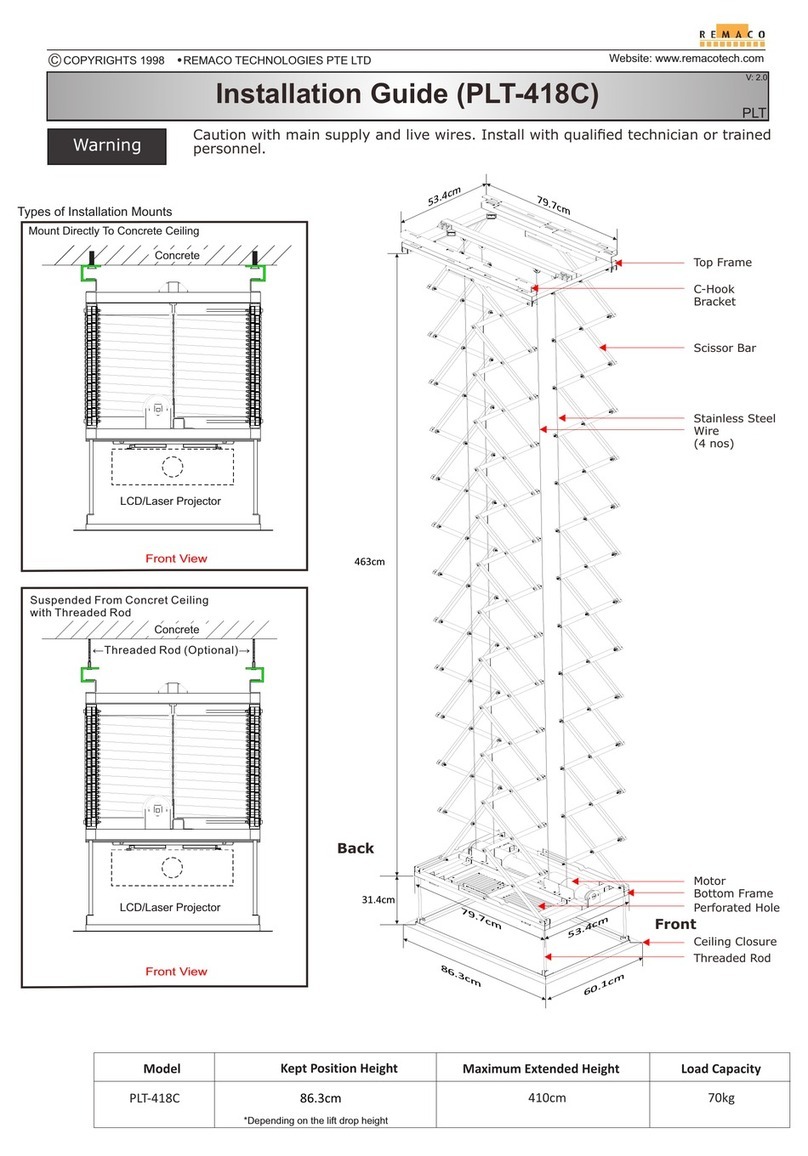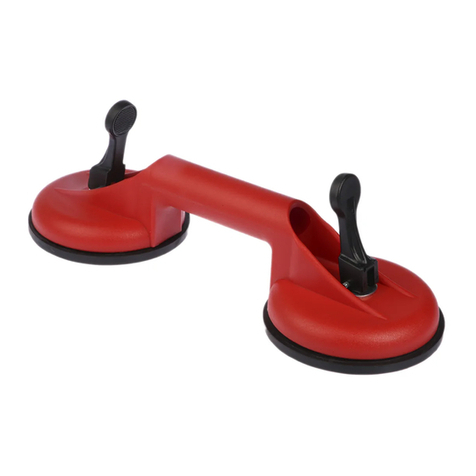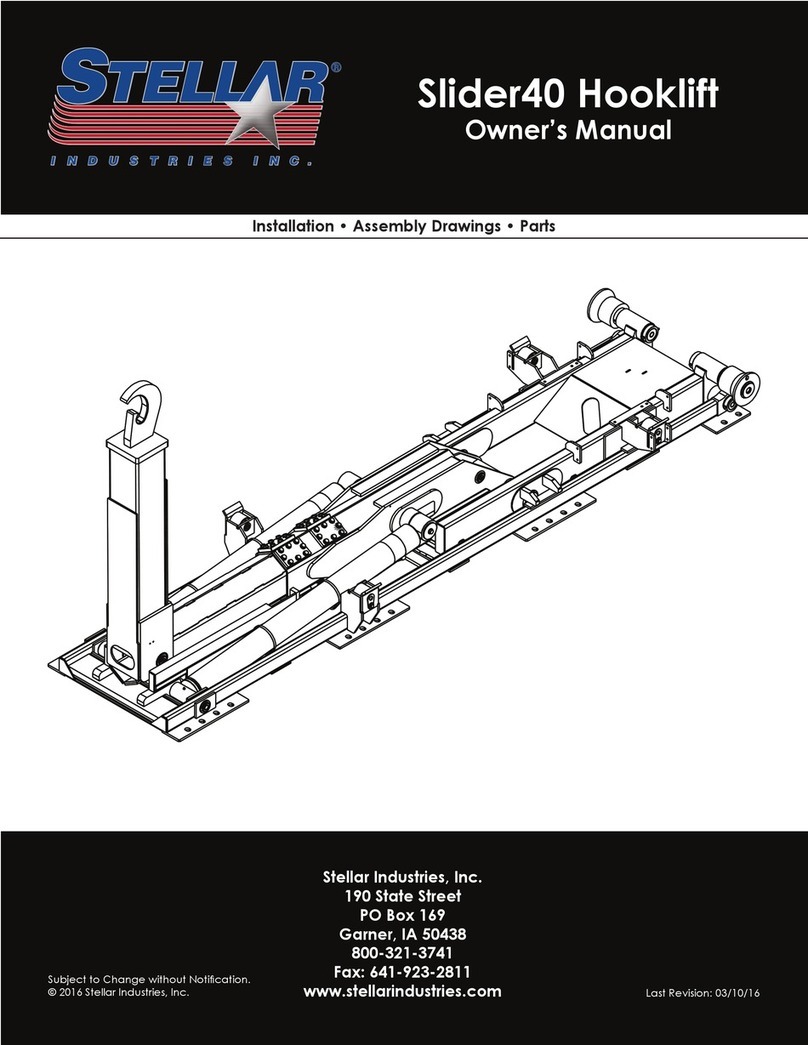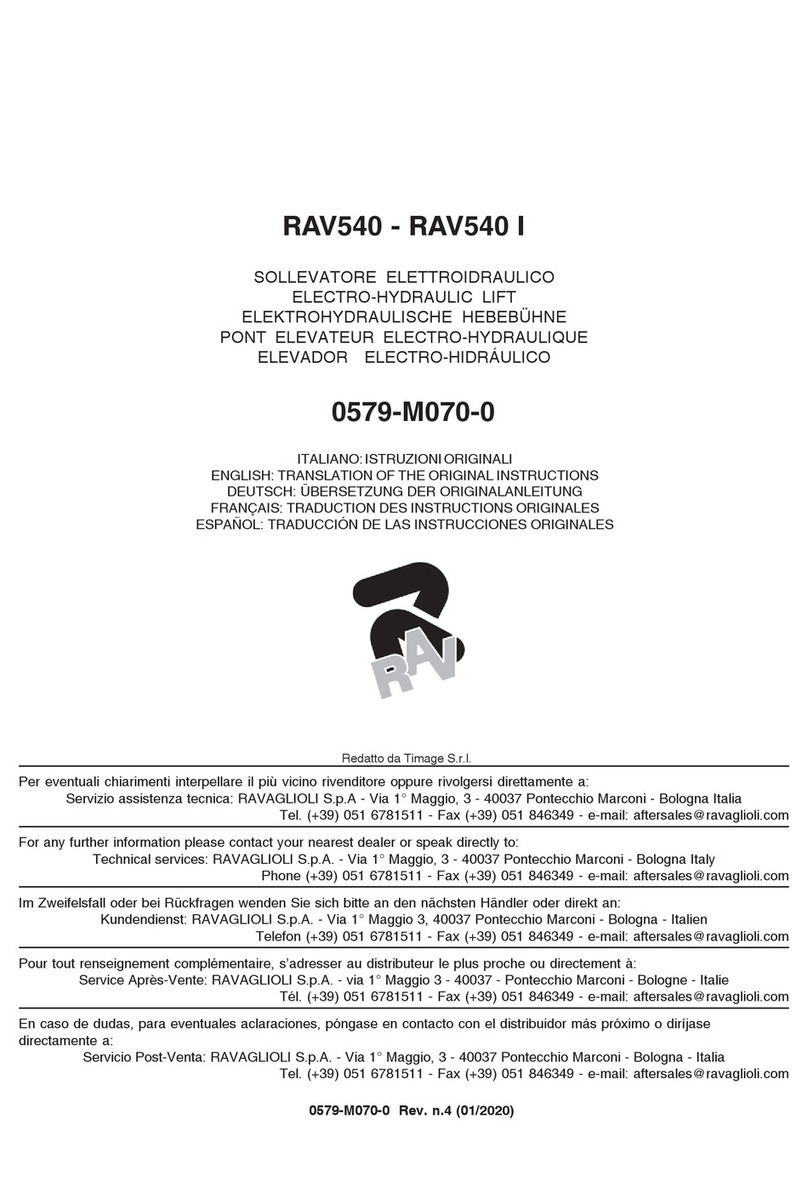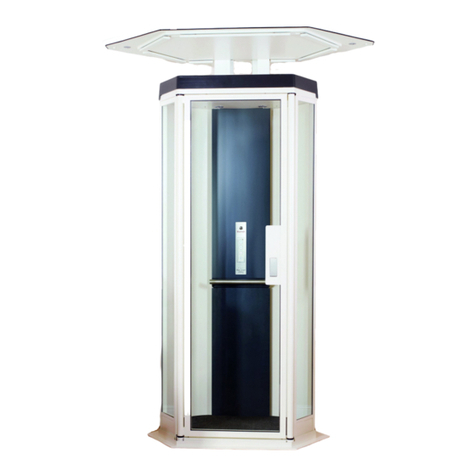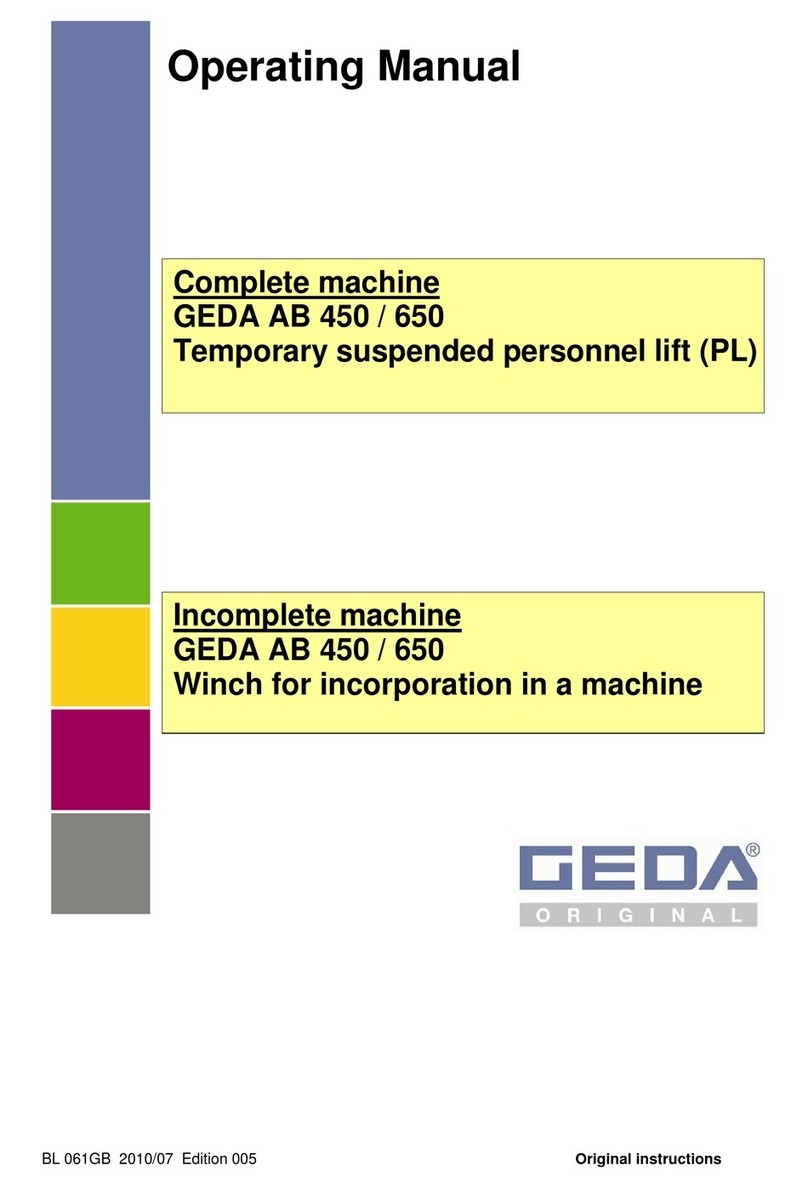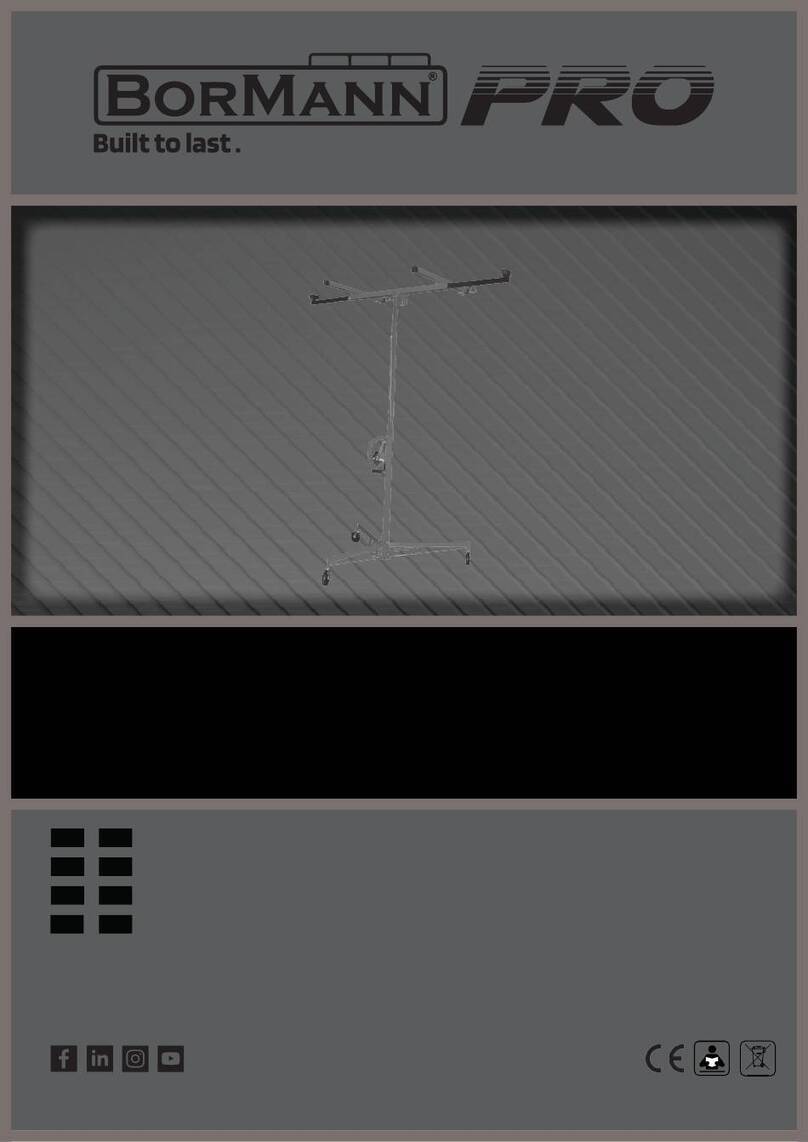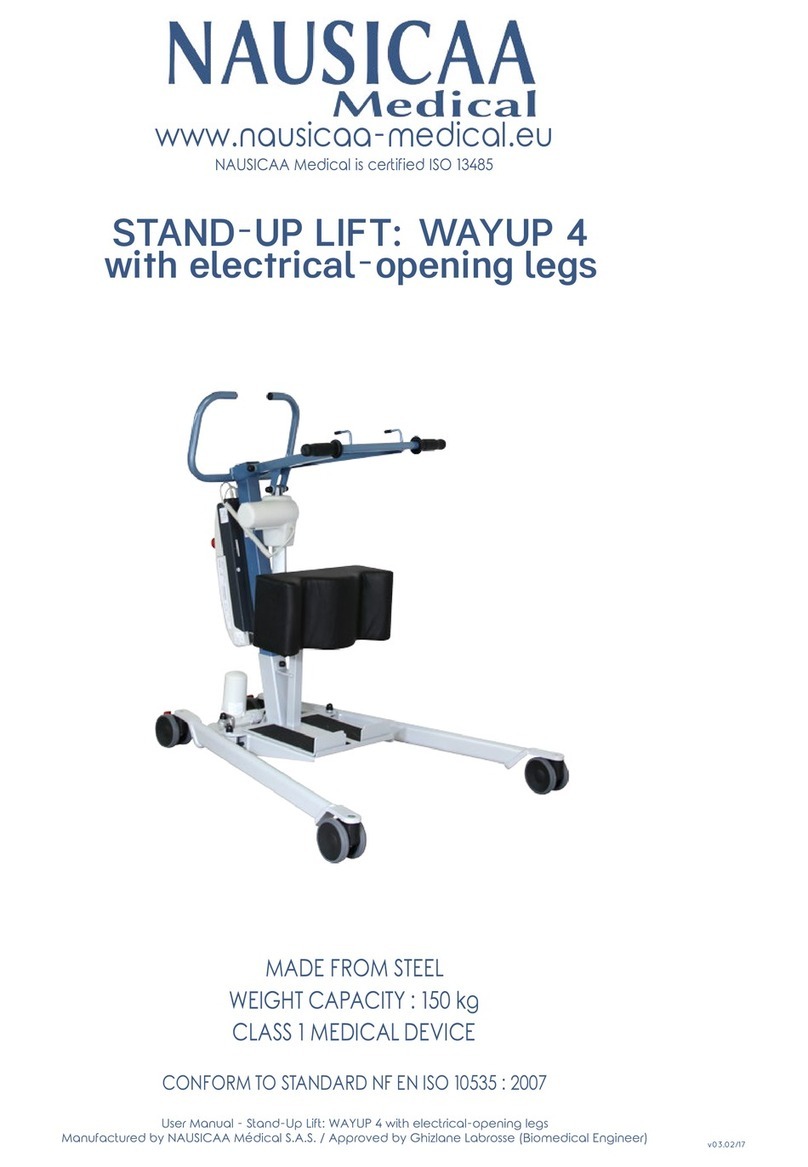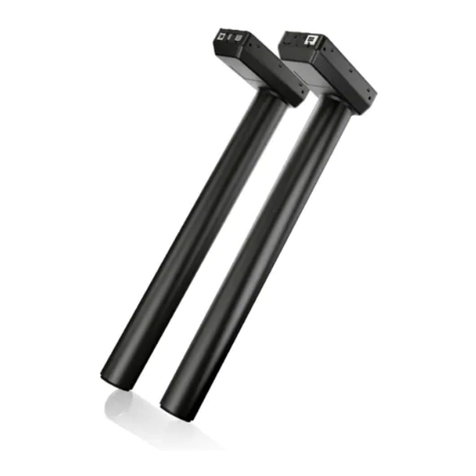tellefsdal AUTO WRAP 1200 EH User manual

2 February 2003
USER'S MANUAL
NORSE AUTO WRAP 1200 EH
CHAP. CONTENTS PAGE
1.0 INTRODUCTION 3
2.0 SAFETY PRECAUTIONS 4
3.0 GENERAL INFORMATION ON BALEWRAPPING 8
4.0 SETTING UP / MOUNTING OF THE MACHINE 10
5.0 EMERGENCY STOP* (Momentarily stop) 14
6.0 MOUNTING OF PLASTIC FILM 15
7.0 REMOTE CONTROL UNIT, CR 900 16
8.0 SPEED SETTING OF THE WRAPPING ARM 22
9.0 ADJUSTING THE OVERLAP 23
10.0 OPERATION INSTRUCTION 24
11.0
12.0 PERIODIC MAINTENANCE 26
13.0 ELECTRIC CIRCUT 29
14.0 DESCRIPTION OF HYDRAULICS 30
15.0 CHECK POINTS BEFORE TROUBLE SHOOTING 34
16.0 PROCEDURE OF TROUBLE SHOOTING 35
17.0 TROUBLE SHOOTING 36
18.0 HYDRAULIC CHART 38
19.0 WARRANTY TERMS 39
* Emergency stop: see chapter 2.1 1

NORSE AUTO WRAP 1200 EH
Bale wrapping machine
1. Wrapping arm motor 7. Main frame
2. Wrapping arm 8. Speed control
3. Prestretcher 9. Stationary arm
4. Rollers 10. Lifting sling
5. Support rollers 11. Emergency stop*
6. Cutter 12. Safety guard
* Emergency stop: see chapter 2.1 2

1.0 INTRODUCTION.
TELLEFSDAL A.S congratulates you with the choice of AUTO WRAP bale wrapping machine. We
are certain you will be satisfied with the machine, and that you will have the pleasure of your
investment for many years.
The AUTO WRAP bale wrapping machine has more features than any other bale wrapping machine
available. AUTO WRAP can pick up the bale, wrap and stack them without the operator leaving the
tractor cab. This system is protected by patent law's almost world wide.
AUTOWRAP 1200 EH is hydraulically driven by the tractors hydraulic system, and is controlled from
the tractor cab by a remote control unit. The machine can either be mounted to three point linkage,
front mounted with quick-couplers to the tractors frontloader or on a wheel loader. Then it's possible
to stack the bales upon each other.
AUTOWRAP1200EHisdesignedtowrapbalesofgrass,heyorstraw,withnominaldiameterof3½
-5½ ft. (110-170cm), and weights up to 1760 lbs. (800kg). The machine is developed and has been
improved since the beginning in 1986, and is now a very reliable and safe machine with high security
built in.
Thismanualismeanttoexplain howAUTOWRAP isprepared,mounted, usedandhow itworks, and
shall together with the spare part's list be a reference for maintenance and troubleshooting. So take
good care of the books, they are a part of the machine.
Read carefully through this manual, and specially chapter 2.0, safety instructions, before starting the
machine, and follow the instructions thoroughly. If problems should occur, check with chapter 17.0,
and try to find out what is wrong. Ask your dealer for advice before you make the problem worse than
it is.
See also chapter 19.0, conditions of warranty.
Technical Specifications AUTO WRAP 1200 EH
Height in working position, min. / max. 2280 / 2480 mm ( 7' 6" / 8' 2")
Width, min. / max. 1290 / 2880 mm ( 4' 2" / 9' 5")
Length, min. / max. 2170 / 3040 mm ( 7' 1" / 10')
Weight 615 kg (1356 lbs)
Wrapping arm speed, recommended 22 revolutions' per minute
Wrapping arm speed, max. 27 revolutions' per minute
Bale size, max. ø1700 mm ( 5' 7")
Bale weight, max. 800 kg (1765 lbs)
Capacity Approx. 25 bales per hour
Prestretcher 500 mm / 750 mm (20" / 30")
Hydraulic connection 1 pcs. single working, + free return
Oil pressure / amount, min. 180 bar / 15 litres per minute
Oil amount, max. 40 litres per minute
Counter pressure, max. 10 bar
Electric connection 12 V DC
TELLEFSDAL A.S can change the construction and/or technical specifications without warning and
without rights to changes on already delivered products.
©Copyright. All rights reserved. Any copying and reproduction of this manual are not permitted
without permission from TELLEFSDAL A.S.
With precaution of printing failure.
* Emergency stop: see chapter 2.1 3

2.0 SAFETY PRECAUTIONS.
TELLEFSDAL A.S does not take the responsibility for damages that may occur on machine,
persons or other equipment, because of the machine NOT being used as described in this
manual, or because of the safety precautions NOT being followed.
2.1 SAFETY EQUIPMENT.
Before using the machine, make sure that all guards and covers are securely fitted. The machine
must not be operated if a function does not work as described later in this manual. (See chapter 2.5).
* EMERGENCY STOP. Auto wrap 1200 EH is equipped with a so-called emergency stop on the
wrapping arm. This device stops all functions momentarily, but is per definition not an
emergency stop, because it does not shut down the inputs. But it has the same function, so
we have decided to call it an emergency stop in this manual.
2.2 BECOME FAMILIAR WITH THE OPERATIONS OF THE MACHINE.
If you are unsure how to operate the machine properly, either use of or maintenance to your Auto
Wrap, please contact your Auto Wrap dealer.
2.3 ADJUSTMENTS' / MAINTENANCE.
Turnoff the tractor and discharge the oil pressure before performing any adjustment or maintenance
on the machine. Remember that a well maintained machine is a safe machine.
2.4 IMPORTANT!
MAKE ALWAYS SURE THAT NOBODY IS IN THE HAZARD
AREA OF THE WRAPPING ARM WHEN THE MACHINE IS IN USE.
THE MACHINE MUST NEVER BE OPERATED BY PERSONS WHOM DOES NOT KNOW ENOUGH
ABOUT HOW TO SAFELY OPERATE THE MACHINE, OR BY PERSONS UNDER 16 YEARS OF AGE.
* Emergency stop: see chapter 2.1 4

Fig. 2-1 Fig. 2-2
2.5 DANGEROUS AREAS.
TELLEFSDAL A.S has given the safety to the operator the highest priority, but it is still impossible to
secure oneself of every danger area on the machine. Therefore we will now go through some of the
dangers that can occur when using the Auto Wrap balewrapper.
1. PUNCH OF THE WRAPPING ARM.
During the wrapping process the arm rotates with a speed of 20-27 revolutions per minute
around the bale. On the arm there is mounted a prestretcher unit with a plastic roll. The
speed on this can give a person serious injuries if one comes to close to the working area
of the wrapping arm. To reduce this danger we have mounted an emergency stop* device
on the wrapping arm, this stops all movement instantly when someone comes in the way of
it. It is very important that this protection always works and that it should not under
any circumstances be unconnected.
(See more about the emergency stop* in chapter 5.0).
2. SQUEEZE-DANGER BETWEEN THE MAIN FRAME AND THE WRAPPING ARM.
As earlier explained, we have a wrapping arm with a prestretcher and a plastic roll. Once
every time around this wrapping arm passes the main frame. Here there may occur a
squeeze danger if a person stands to close to the main frame when the wrapping arm
passes. The distance between the main frame and the wrapping arm is not large enough to
give place for a person. Between the prestretcher and the bottom frame there can also be
a squeeze danger.
To protect the user from this there is mounted a protection guard on the right hand side of
the machine. You lift this up and turn it out on the side of the machine when operating the
baler. You put it in transport position by lifting it up and turning it into the frame. (Fig. 2-1).
The guard must not under any circumstances be removed, and if damaged it must be
repaired before the machine is used again.
3. SQUEEZE-DANGER BETWEEN THE STATIONARY AND THE WRAPPING ARM.
During the main wrapping process the wrapping arm moves around a stationary arm. Every
time the wrapping arm passes the stationary arm, there is a squeeze danger that can be
dangerous for the fingers. The distance between the stationary and the wrapping arm is
between 25-40 mm. (See fig. 2-2).
* Emergency stop: see chapter 2.1 5

Fig. 2-3 Fig. 2-4
4. SQUEEZE DANGER BETWEEN THE ROLLERS AND THE MAIN FRAME.
During the wrapping process the bale rotates on two rollers. These two rollers rotate around
the square pipe they are mounted on. Between the roller and the square pipe there is a
squeeze danger for the fingers. (See fig. 2-3).
5. SQUEEZE DANGER BETWEEN TELESCOPE FRAME AND MAIN FRAME, INWARDS.
When loading a new bale, the telescope frame moves into the main frame, and this is where
there can occur a squeeze danger. This is secured with a cover on the telescope frame that
slides on the main frame.
The machine must not be used if this cover is removed or damaged.
6. SQUEEZEDANGERBETWEENTELESCOPE FRAMEANDMAIN FRAME,OUTWARDS.
Onboth ends of the telescope frame there can occur a squeeze danger when loading a new
bale. Keep therfore hands and feet away from this area. (See fig. 2-4).
7. SQUEEZE DANGER CAUSED BY PLASTIC AUTOMATION.
Attheendofthewrappingprocesstheplasticshallbeperforatedandheldtightuntilthestart
of thenextwrappingprocess.Whenthecutterarmmovesdowntolocktheplastic,therecan
occur a squeeze danger between the cutter arm and the cutter holder. The cutter blade that
perforates the plastic is very sharp, so keep hands away from the cutter. (See fig. 2-5).
Always put the security cover over the cutter blade when the machine is not in use.
* Emergency stop: see chapter 2.1 6

Fig. 2-5 Fig. 2-6
2.6 LOCKING THE WRAPPING ARM.
Whenthe machineisnot inuse,make surethelocking boltforthe wrappingarmis mounted,andthat
the secure pin is fitted. If the bolt is not mounted, the wrapping arm and/or the machine could be
damaged during transport. (See fig. 2-6).
2.7 THREE POINT MOUNTING.
When the machine is mounted in the three point linkage, make sure that the lifting arms are tightend
up so there is no sideways movement.
2.8 FRONT MOUNTING.
Ifthemachine ismountedon thefrontloader theremustbe acounterweightin thethreepoint linkage.
It must be large enough to give the tractor good stability.
Connecting heavy working implements often has an overall negative effect on the tractor's
driving and braking capacity.
2.9 TRANSPORTING.
When transported on a public road there are certain safety measures that must be taken:
1. Make sure that the locking bolt on the wrapping arm is mounted. (Chapter 2.6).
2. Lift the protection guard, turn it into the machine and secure it with the locking pin.
(See chapter 2.5.2).
3. Move the main rollers completly together.
4. Always transport the machine in the lowest possible position.
5. Makesure that the machine do not cover the tractors lights. If necessary, mount extra lights.
6. Make sure that at least 20% of the tractor's total weight is on the steering wheels.
7. If the machine is front-mounted, it's necessary to balance the weight with a counterweight
mounted to the three-point linkage.
!
* Emergency stop: see chapter 2.1 7

3.0 GENERAL INFORMATION ON BALE WRAPPING.
3.1 THE PRINCIPLE.
The advantages of round bale ensilage are many, and include fewer feed units, a flexible harvesting
system, large capacity and the possibility of selling feed units.
In principle, the same fermentation processes occur whether the fodder is placed in a silo or pressed
into bales and packed in plastic, i.e. lactic acid fermentation in anaerobic conditions. The oxygen in
the bale must be exhausted before fermentation begins.
The grass should be dried to approximately 30-40% solid content. The solid content can be
determined by twisting the grass by hand. If drops of liquid are forced out of the grass, the solid
content is less than 25%. Low solid content, (wet grass), can lead to increased butyric acid
fermentation if preservatives are not added to the grass. If the solid content is too high, (over 50%),
normal fermentation will not take place and there will be enough oxygen in the bale to produce mould
fungus.
3.2 THE BALE PRESS.
It is vital that the bale press produces compact, well-formed bales, as misshapen bales can be
difficult to pack. Pressing will also often take longer, thereby increasing the amount of plastic used.
3.3 DIFFICULT BALES.
Whena misshapenbaleis packed,itwill haveatendency tomoveoutwards orinwardson therollers.
If the bale begins to move outwards, the machine must be lifted slightly at the rear edge to get the
baletorestagainstthesupportrollersonthemainframe.Itcanthereforebeusefultouseahydraulic
top stay to make this adjustment easier. (See chapter 4.2).
If the support rollers almost disappear into the bale the machine should be pressed down slightly at
the rear edge in order to remove the bale from the machine. The plastic can be damaged when
friction against the rollers increases. Best results are achieved when the bale rolls easily against the
support rollers all the time.
If the bale to be packed is conical you must ensure that the sharp end is pointed at the tractor. It will
then be easier to get the bale to lie correctly during packing. It is easy for such a bale to "turn" forward
in the direction in which it is pointing, and therefore lie against the support rollers. If the bale is lying
on a slope it must be picked up from the lower side. A hydraulic top stay will again be advantageous.
3.4 TYPES OF PLASTIC.
Agood type of plastic with good adhesive properties, and which is recommended for bale wrapping,
must be used. The thickness of the plastic foil should be at least 25 µ. (25/1,000 mm). In order that
theplastictightenssufficientlyaroundthebale,itisstretchedbeforebeingwrapped,soitissomewhat
thinner when it is put on the bale. With short-term storage, (up to eight weeks), it is recommended
that bales have a minimum of four layers of plastic at the thinnest points, with at least 52-53%
overlap.
For long-term storage, or when the grass is wet when it is packed, the bale should have 90-100 µ
plastic, (6 layers), and the same amount of overlap. If thinner plastic is used, more layers should be
applied. If it is very hot the plastic will be stretched further, and more layers should be applied. It is
better to have slightly too much than too little plastic on the bale.
From experience, light plastic produces slightly lower temperatures within the bale, and tends to
improve feed quality.
* Emergency stop: see chapter 2.1 8

3.5 STORAGE LOCATION.
Care should be taken in finding a suitable location for the storage of bales. The storage location
should preferably be prepared before the bales are laid out. An elevation close to well-drained roads
is recommended. If the wrapped bales are simply placed on stubble there is a danger of the plastic
being pierced. A tarpaulin or a thin layer of sand should therefore be laid where the bales are to be
stored over the winter.
Bales should be stored in the shade as far as possible. This reduces the danger of air leakage in the
bales.Abalewhichisstoredinsunlightandwhichthereforeundergoesgreaterswingsintemperature
"pumps in" a great deal of air in comparison to a bale which is stored in the shade. According to
"Teknik for Lantbruket" [Technology for Agriculture] in Sweden, a bale which is stored in the shade
has only 40% of the air leakage of a bale which is stored in sunlight.
3.6 STACKING / PROTECTION.
If bales are hard and well formed, they can be stacked vertically, but loose and misshapen bales with
low solid content should not be stacked higher than one layer, as this could easily cause deformity
and the danger of runoff will be increased.
Bales can also be stored on their sides. The layer of plastic is thicker here, providing greater
protection against piercing.
Bales should be covered with a tarpaulin or a fine-mesh net to protect against birds and small
rodents. If the plastic is pierced, it must be sealed with weatherproof, hard-wearing tape, preferably
under the outermost layer of plastic. Ensure that the hole is adequately sealed.
3.7 The best wrapping results are obtained by...
i ...harvesting the grass early.
i ...drying it out to 30-40% solid content. If there is a danger of rain, press and pack the
grass anyway.
i ...taking care not to mix any earth in with the grass.
i ...using a press that produces even, firm bales.
Bales 1.2 m in width and with a diameter of 1.2-1.5 m are the preferred sizes.
i ...packing the bales soon after pressing, never later than two hours afterwards.
i ...using a good type of plastic and six layers of plastic. This removes the need to use
preservatives.
i ...storing bales in the shade to reduce the danger of air leakage.
* Emergency stop: see chapter 2.1 9

!
Fig. 4-1
4.0 SETTING UP / MOUNTING OF THE MACHINE.
Be careful! There is a danger of being crushed when working implements are fitted and
connected. Carry out the fitting procedures slowly and carefully, and use separate and
approved lifting equipment to make the work easier. See section 2 on safety regulations and
pay attention to the various safety decals displayed on different parts of the bale wrapper.
4.1 THREE POINT LINKAGE.
AUTO WRAP 1200 EH is intended for rear mounting to the three point linkage, category 2. With
consideringof transportationarenot thethreepoint bracketsmountedon themachinewhen itleaves
the factory. (See spare parts list chapter 2-1 for more details). When attached to three point linkage,
make sure the machine is level across the tractor. Tight up and lock the lifting arms so there is no
sideways movement.
4.2 TOP LINK.
Adjust the top link of the tractor so that the machine is level with the ground. It is recommended to
use a hydraulic top link, as this makes it easy to adjust the angle of the machine.
During the wrapping process it is recommended to tilt the machine towards the tractor, as this will
prevent the bale from falling off the rollers. (See fig. 4-1).
4.3 FRONT MOUNTING.
Asextraequipmentthemachinecanbeequippedwithquick-couplersforfrontloaderorwheelloader.
(See spare parts list chapter 2-2 for what types of quick couplers there are).
You also need longer hydraulic hoses. (See spare parts list chapter 4-2 for more details).
Whenfront-mounted theremustbe mountedalarge enoughcounterweightin thethreepoint linkage,
this is to secure the tractors stability.
* Emergency stop: see chapter 2.1 10

Fig. 4-2
4.4 ELECTRIC CONNECTION.
The electric supply for the machine's remote control and electro-hydraulic components must come
directly from the tractors' 12 volt battery.
The electric wires from the battery must have an area measurement of min. 2,5 mm2.
Connection to other contacts on the tractor can cause risk of misfunctions, and is not to recommend.
To secure the electric system against short-circuits there is an 10A fuse on the plus-leader, near to
the battery pole.
BROWN LEADER GOES TO BATTERY PLUS POLE
BLUE LEADER GOES TO BATTERY MINUS POLE
REMOTE CONTROL.
The control unit should be attached to a suitable place in the tractor cab, next to the front loader's
operating lever if the machine is front mounted.
THE REMOTE CONTROL UNIT IS NOT SHOCK-PROOF. MAKE SURE THAT IT IS FASTENED
TO A SOFT PAD THAT SECURES A NON-VIBRATING FOUNDATION.
* Emergency stop: see chapter 2.1 11

Fig. 4-3 Fig. 4-4
4.6 HYDRAULIC CONNECTION.
The hydraulic hoses between machine and tractor are equipped with 1/2" ISO male quick-couplers.
Discharge the oil pressure before you connect the oil hoses. Use the tractors' hydraulic lever.
To make sure that the balewrapper works properly, the tractors' oil pressure has to be at least 180
bar. The oil flow should be 15 - 25 litres per minute.
The counter pressure on the return must be as low as possible, and not exceed 10 bar. This should
bemeasuredwithagauge.Itisrecommendedtouseonesingle-workinghydraulicoutletandarrange
afree return circuit to the oil tank. If you are unsure of what oil pressure the tractor gives, or what oil
pressurethebalewrapperreceives,pleasecontactyourmachinerydealer.Generallyalltractorshave
got some counter-pressure in their hydraulic return systems. Some tractors have more than others.
Hose with red cap shall be connected to pressure, (P), and hose with blue cap to the return.
(T). (See fig. 4-3).
4.7 OPEN AND CLOSED CENTRE HYDRAULIC SYSTEM. (See also chap. 14.1).
With the ball valve you can choose between a hydraulic system with open or closed centre. Almost
all tractors have a hydraulic pump that gives a fixed oil flow per revolution. (Open centre). The valve,
(with the red handle), shall then be in open position. Some tractors, (like f.i. John Deere), have an oil
pump with variable volume per revolution. (Closed centre). The ball valve shall then be in closed
position. (See fig. 4-4).
* Emergency stop: see chapter 2.1 12

Fig. 4-5
4.8 CHECK LIST.
Before using the machine it is recommended to follow this check list:
1. Make it a habit to discharge the oil-pressure before connection or disconnection of the
hydraulichoses.(By operatingthehydraulic controlleverinside thetractor).(Use thetractors
hydraulic control lever).
2. Return-oil should be led as directly to tank as possible. Beware that if the counter pressure
is too high, the security valve on the main block will release some oil. (See chapter 14.3).
3. Hose with BLUE CAP = RETURN OIL.
4. Hose with RED CAP = PRESSURE.
5. Tie up loose hoses so that no squeeze damages occur.
6. Removethe lockingboltthat holdsthewrapping armtothe frameduringtransport. (Fig.4-5).
7. Makesure that the plug-in contact from the remote control is connected to the socket on the
machine.
8. Start the tractor and try out the functions. A bale is not required for this test.
9. Check all connections, hoses and couplings. If there is any oil-leakage, it should be rectified
immediately.
If any problems should occur, it is most likely that the failure is in the quick-couplers on the
tractors pressure and return-connections.
They can be very narrow and work badly after some years.
Make sure that both the male and the female-couplers opens properly for the oil flow. Check
them carefully. The best thing to do is to exchange the quick-coupling on the return side and arrange
a "free return".
Your AUTO WRAP bale wrapper has been tested in practical operation in approx. 2 hours at
the factory.
* Emergency stop: see chapter 2.1 13

Fig. 5-1
5.0 EMERGENCY STOP*.
5.1 Themachineisequippedwithasafetyguardonthewrappingarm,anditsoperationmustbetested
before work itself is started.
5.2 The safety guard is designed to stop the wrapping arm injuring operators or objects either when
starting up or when wrapping bales.
5.3 The emergency stop* is constructed with a "positive" connection, i.e. it has to be in full order before
the machine can be started.
5.4 It consists of a releaser hoop that activates a small electric switch. (See fig. 5-1).
When the electric circuit is broken, the valve shuts off the oil, and the wrapping arm stops. This is
shown in the display on the control-unit by three points lighting up. (See chapter 7.1.1, paragraph e).
5.5 When this function shall be tested, you start the wrapping arm. Hold out an arm or any obstacle. The
wrapping arm shall now stop before it hits the arm.
5.6 Torestart themachinethe obstaclemustbe removedandthe safetyguardmust returntoits original
position. If "STOP" (9) is pressed before "START" (8),the wrapping continues from the point in the
program at which the emergency stop was activated. If, on the other hand, "STOP"(9) is pressed
before "ZERO"(3),then the wrapping sequence starts from the beginning again. (See further in
section 7.9.)
5.7 When the machine has been parked for some time, there might be copper acetate on the skidding
rings, so there is no contact. If so, the machine cannot be started. Rub carefully off the rings with a
fine rubbing paper. Clean it up with some alcohol or electric contact spray.
NB! TO GET A RELIABLE MACHINE, IT IS VERY IMPORTANT TO ALWAYS KEEP THE SKIDDING
RINGS AND BRUSHES CLEAN AND IN ORDER AT ALL TIME.
* Emergency stop: see chapter 2.1 14

Fig. 6-1 Fig. 6-2
6.0 MOUNTING OF PLASTIC FILM.
6.1 Whentheplasticrollshallbemounted,youhavetoholdtheprestretcher-rollersaside,Holdtherollers
aside and put on the holding hook. (See fig. 6-1).
6.2 Place a reel of film on to the prestretcher's holding axle and put on the springloaded lock.
6.3 Pull the film between the rollers on the prestretcher in the direction of the arrow. (See fig. 6-2).
(See also the sign on the wrapping arm).
6.4 The filmholder / cutter opens by pushing CUTTER OPEN, (5), on the remote control block.
Pull out the film and place it over the U-shaped slot.
6.5 Push the CUTTER CLOSED-button, (4), and the film will be held in the U-shaped slot.
6.6 HEIGHT ADJUSTMENT OF PRESTRETCHER / PLASTIC FILM.
Theplasticfilmshallhitatthemiddleofthebalewrapped,andthereforeitcanbenecessarytoadjust
the height of the prestretcher. (See more about this in chapter 10.2).
If you use 500 mm plastic on a 750 mm prestrecher, then you can use the two distance sleeves to
adjustthe height on the plastic roll. There can be mounted one sleeve on each side of the plastic roll,
or both sleeves can be mounted above or below.
* Emergency stop: see chapter 2.1 15

7.0 CONTROL BOX
The Tellefsdal control system is developed with the intension of assisting the operator to
maintain full control of wrapping machine. The system provides for detailed instruction and
massages via the 40 character alpha-numeric display, enabling the operator to monitor the
operation of the wrapmachine at any inststant.
The system is equipped with various test programmes, wraping messages, error messages and
instructions which makes the system superior in terms of facilities, service and operation.
THE DISPLAY UNIT AND PANEL FUNCTIONS
FUNCTION DESCRIPTION.
PRESELEKT
The menu scroll up/down key. Is used for the mode the operator wishes to view.
It is also used for incrementing values such as required number of film layers
and other machine parameters when in the SET mode
The menu scroll up/down key. Is used for such for the mode the operator wishes
to view. It is also for decrementing values such as required number of film
layers and other machine parameters when in the SET mode.
The SET key is used for enter the programming mode and to reset values in for
example the bale counters.
* Emergency stop: see chapter 2.1 16

When in “SET” mode, this is used to exit the “SET” mode in order to reenter
the operative mode.
Allows for adding extra film layers to the bale both during the wrapping cycle
and at cycle restart. During the cycle one push will cause the required number of
film layers to increase by 1, two pushes 2 additional layers etc. Is the button
activated after the cycle is completed but before offloading of the bale, one push
followed by a RUN command will cause the cycle to restart and apply a
minimum number of 2 layers in order to control the cutting device.
Activates the film cut/ hold devices for manual operation. The manual operation
of the device is not accessable during an automatic operation.
1:Activates the WRAP ARM for manual operation. The wrapping will
commence in slow speed and then accelerate to fast speed. When the manual
wrapping is completed the speed will return to slow after which the wrap arm
will stop. The wrapping will only remain while the FUNCTION SWITCH is
activated.
2: Activates the WRAP ARM for manual operation in slow mode. The
wrapping will only remain while the switch is activated.
1: Moves the rollers inward, bale loading.
2:Moves the rollers apart, bale offloading.
1: MANUAL bale LOADING function is operated via this switch.
2: MANUAL bale OFFLOADING function is operated via this switch.
1:Bale lifting.
2: Bale rotation.
* Emergency stop: see chapter 2.1 17

FUNCTION DESCRIPTION
PRESELECT
The AUTO switch will initiate the AUTOMATIC cycle. It may also be used
to cut the cycle Wrap cycle short. Example: The wrapping cycle is set to 30
film layers. The operator wishes to complete the cycle and offload the bale
using only the automatic facilities of the system. Activating the AUTO switch
during an automatic cycle, will cause the controller to consider the bale as
completed and the machine will position the wrapping arm on the sensor
when ready and the bale may be offloaded.
The STOP button will cause the machine to stop any process instantly
irrespectively of the operation in progress. A START command will at this
stage restart the cycle from where it previously was stopped, continue the
cycle and complete according to the programme.
MODES OF OPERATION.
The system is designed so that the automatic mode and the manual mode is seperated by a
STANDBY MODE. This means that when operated in the automati mode, all manual commands
are ignored with the exception of the ROLLER in, OUT and the BALE SPIN STOP fuction and
additional film layer function. In other words all other manual function are only accessable
when in standby mode.
STANDBY MODE.
Standby mode is the waiting state between the Auto and the Manual mode. Standby mode is
automatically resumed when:
1. An automatic cycle is completed.
2. Between cycle steps, It is here in STANBY for a operator command for manual or
automatic function. A AUTO command will instruct the machine to advance to the next logical
step in the auto cycle, namely the offloading of the bale if this is defined in the setup where as the
system in manual only will execute the requested function activated on the manual switch.
3. Stopping the cycle will at any stage bring the system into standby mode.
The machine is generally required operated automatically with the exception of the BALE
offloading and loading. The controlling system will with its standard factory setting,
automatically control the machine with AUTO commands. For every programme step, the
machine has completed, the machine will stop and await further command from the operator.
During a normal automatic cycle the machine will via the audio alarm, inform the operator that
the wrapping cycle has now been completed and that bale is ready to be offloaded.
OPERATOR INSTRUCTIONS.
MANUAL FUNCTION.
When the machine is in standby mode the computer will perform the function illustrated on its
associated switch for manual operation.
* Emergency stop: see chapter 2.1 18

LOAD AND WRAP CYCLE. ( Round and Square bales.)
The semiautomatic loading function may be engaged and disengaged by the operator in the user
setup. This function is on the display shown as “ Manual rollers-in hold duration: xx “ seconds.
Typically the programme for the automatic cycle is set to follow the described sequence:
TO LOAD BALE: push “ rollers in “ switch.
The machine will now load the bale and commence the cycle according to the
programme.
TO OFFLOAD BALE:
Use manual switches to position the square bale correctly and lower the bale to the
ground.
The semiautomatic offloading function may be engaged and disengaged by the operator in the
user setup. This function is on the display shown as “ Manual rollers-out hold duration: xx “
seconds.
THE DISPLAY MENUES.
At the operator level there is a number of menus which enables the operator to perform various
tests and adjustments to the machine operation. Should adjustments of parameters which are not
accessable to the operator be required, please contact the TELLEFSDAL dealer or
TELLEFSDAL A/S.
DISPLAY INDICATION FOR DESCRIPTION.
NEXT
VIEW
WRAP CYCLE 15 : 20 0 This operative display shows the commonly most
BALES : 1 324 needed information. The number 15 indicates the
actual number of applied film layers at this
instant. The number 20 is the operator
programmed film layer requirement. The number
1 is the bale counter in use and the number 324 is
the quantity of bales registred in counter number
1.
The “0" (zero) in the top right hand corner means
that there is a bale positioned on the table.
SETUP ( 13100 )
Press SET to enter. This is the operative service level. When in this
mode the operator is able to engage / disengage
the various sensors. Also variables such as LOAD
AUTOMATICALLY UPON AUTO SIGNAL
may here be set or adjusted.
* Emergency stop: see chapter 2.1 19

AKTUAL RPM 29
ALARM LIMITS: 20-30
The 20 - 30 indicates the programmed limits of
the wrapping speed. Should the speed exceed 30
rpm or fall below 20 rpm, the audio alarm will
sound if engaged and the display will show this
message.
“ Actual RPM “ is the wrap arm speed at any
given instant.
BALE COUNTERS
Press SET to enter. The system contains 10 bale counters. When this
disply is shown, it is possible to inspect the bale
counters. Machine total ( the sum of all bales ever
made on the machine.) And the quantity of each
individual bale counter.
WORKING HOURS: 122
MACHINE TOTAL: 798 Displays the number of working hours of the
machine in 1 week, day or other (resettable) and
the total number of the machine operating hours.
(Not a resettable facility).
LANGUAGE: ENGLISH The system may contains a number of languages
for all SETUP parameters, messages and operator
instructions. The language required for display
messages may be chosen ( if available ) via this
meny.
AUDIOALARM &
DISPLAY
Press SET to enter
The contrast adjustment needed depends on the
viewing angle and the light conditions in the
cabin. 100 is maximum contrast and 0 is
minimum. The contrast may at all times be
readjusted on the MENU up / down buttons
without entering this display. The contrast setting
is preset to 50.
HARDWARE TEST
Press SET to enter The hardware test programme is a tool facility
enabling and inspect almost all functions,
switches and push buttons on the system.
It also contains a battery supply voltmeter which
automatically will be displayed should the voltage
drop below 8 volt during the operation.
SETTING UP THE SYSTEM:
All functions are preadjusted from the TELLEFSDAL factory and commonly the only adjustment
which the operator needs to make, is the programmed number of film layers required.
TYPICAL OPERATOR PROGRAMMATION. ( Standard for all machine models.)
1: Required number of film layers. (Changing from 20 to 25 layers.)
2: Bale counter selection.
* Emergency stop: see chapter 2.1 20
Table of contents
